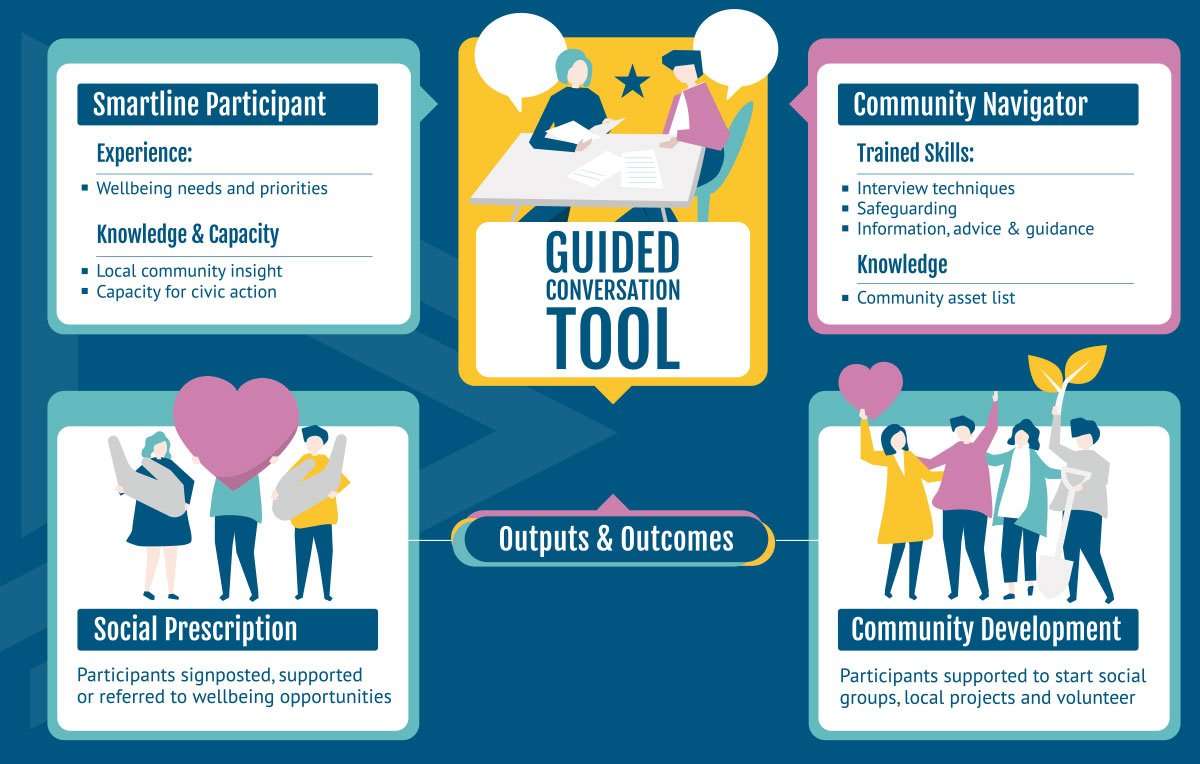
Smartline Research
MAP Digital Projects
A conversation about how to make guided conversations more accessible resulted in a long-term collaboration between Smartline and Cornwall-based design agency, MAP Digital Projects. Working together, the teams created an innovative new way to make paper-based interviews interactive. Find out how we turned a chat into a new type of conversation…
“As a Start Up we have a lot of previous career experience but working for ourselves on our own business is still very new. It’s been a game changer for us to be introduced to the supportive people and opportunities that exist within the Smartline team. It’s opened up opportunities in a new area, both geographically here in Cornwall and in terms of thinking about the role of design in social care and wellbeing, which is a new field for us.”
The background
This is a video from an earlier stage in the project. Take a watch to see how it started.
How can voluntary organisations have more inclusive and interactive conversations with their participants?
Digital-only methods excluded too many people, while more classic interviews could pose barriers, often by not being as visual. The answer lay in guided conversations.
What is a guided conversation?
A guided conversation is a fact-finding dialogue. It’s a method often used by voluntary and community sector organisations (VCSOs) between community navigators and participants.
Because the main reason is often to identify wellbeing needs and come up with achievable action plans, it’s essential that the conversation is supportive, inclusive and never daunting (hence “guided conversation” rather than “interview”). The outputs can range from social prescriptions to new community initiatives, so having a supportive conversation framework that’s able to draw out information is essential.
“As an Early Career Researcher it’s fulfilling to apply research methods to support an SME to co-develop a new product. On the other side of the coin, there is much to learn from collaborating with enterprises. MAP are innovative designers, and when these skills are applied to complex social challenges the results are brilliant.”
The opportunity
This image shows the digital version of the toolkit.
Working with the Community Investment Team at Coastline Housing, we identified a need for a more visual aspect to these conversations. MAP wanted to develop a product that could provide the solutions.
A user-led design could improve the experience for both participant and interviewer, while interactive elements could capture changes and progress, as well as making the experience more engaging. Unusually, this would take the form of a physical as well as a digital product.
To be truly inclusive, the new tool needed to be a hybrid product, with both digital and paper-based versions. The team at MAP were incredibly engaged and motivated to meet this challenge of an interactive physical toolkit. Unlike conventional design projects, this one had to evolve as the research developed.
We began with In Residency support, which included co-production workshops run with Coastline Housing and other Voluntary Sector & Community Organisations (VSCOs). This phase was to identify the design specifications and begin to develop a prototype.
The next phase was a successful application for a Follow-On grant. This enabled the production of a minimum viable product (MPV) with continued input from Coastline Housing and VSCOs. Every element was co-designed with end-user participation.
This is an example of the visual toolkit (photo credit: Habitus Toolkit (physical edition) designed by M-A-P Digital Projects)
A new type of conversation
Our project about conversations has led to a lot of positive dialogues with local VSCOs. MAP has now printed 500 toolkits. These are being used by our partners at Coastline Housing, as well as Porth Eden Crisis Café and Newquay Orchard.
“I cannot wait to use the toolkit with customers. In the voluntary sector, people often get just good enough. This far exceeded that. It’s so different to give people something so high quality.”
At Smartline, we’ve also gained a valuable new partner in MAP. There’s now a close relationship between research and design, which helps to create tools that really work. The partnership has also led to the successful grant application for the £5m Healthy Ageing through Innovation in Rural Europe (HAIRE) project, funded by Interreg 2 Seas and the European Regional Development Fund from 2020-2022.
“We have been able to create a socially useful project for the community at large. Having such a broad user base rather than a narrow client focus and being able to combine that with a thoughtful, critical design approach to the brief is a rare opportunity.”
Images bring the guided conversations to life (photo credit: Habitus Toolkit (physical edition) designed by M-A-P Digital Projects).
Who is involved?
Smartline’s Dr Tim Walker, Stephen Hickman, Prof Catherine Leyshon, Dr Michael Leyshon and Emma Seymour have worked alongside Dr James Moore and Lynwen Anthony from MAP.



